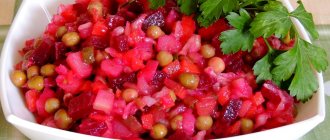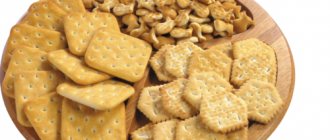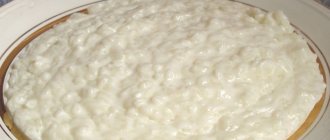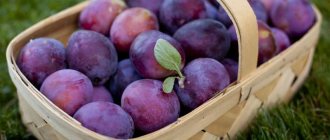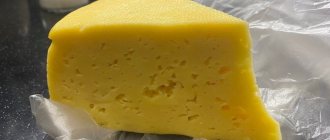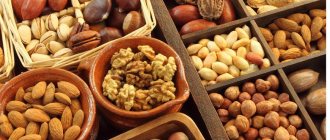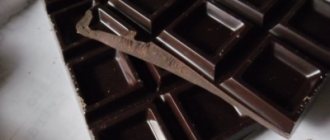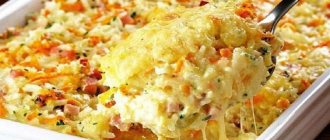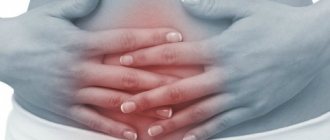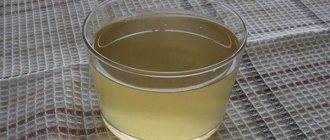Beetroot is an invaluable vegetable for the human body. It is rich in useful elements that improve the functioning of the digestive system. In addition, it must be included in the menu for anemia and decreased tone.
But are beets good for pancreatitis? Gastroenterologists warn that in some cases the vegetable should be treated with great caution. You need to know exactly when and in what form it is best to use beets so as not to harm the inflamed pancreas.
The benefits of beets for inflammation of the pancreas
Just one hundred grams of red vegetable provides a person’s daily need for important elements:
- in chrome – up to 40%;
- in iron, manganese and cobalt – up to 20–25%;
- in iodine and calcium – up to 10%.
Due to its richness in minerals and nutritional value, the vegetable is recommended by nutritionists for almost all health diets. It is also recommended to use beets for cholecystitis or pancreatitis in order to support the normal functioning of internal organs and systems:
- improve metabolism;
- remove toxins and cholesterol;
- improve blood circulation;
- stimulate the thyroid gland;
- increase immunity;
- inhibit the growth of tumor formations.
Beets cleanse the intestines well and treat frequent constipation. And with diseases such as inflammation of the pancreas, all these beneficial qualities of the product can help the body recover faster, renew itself and work with renewed vigor.
How to use juice? Basic Rules
In order not to create additional work on the pancreas, it is necessary to comply with the conditions for taking beet juice. For this purpose, you need juice after preparation:
- stand in a dark, cool place for at least three hours;
- mix with liquid or drinks, for example with other juices - potato-carrot, cabbage, carrot;
- start taking it with a certain amount, then increase it over time;
- take it no more than once every seven days;
- If you have nausea, vomiting or certain body reactions, the drink should not be consumed.
The effect of beets on the body during pancreatitis
Due to its rich composition of minerals, beets help correct metabolism, especially fat. This is an important aspect for such pathologies as pancreatitis. By ridding the body of accumulated toxins, the vegetable facilitates the task of the pancreas during a period when the production of necessary enzymes fails.
Beetroot juice stimulates the blood to more actively deliver nutrients to the organs. A special substance - betaine - cleanses blood vessels and capillaries and reduces pressure in them. This significantly reduces the likelihood of developing complex pathologies due to pancreatitis.
In addition, the substances of the natural product stimulate gastric peristalsis. People with chronic inflammation of the pancreas often suffer from constipation. Eating beets also solves this problem.
However, we must not forget about contraindications. It is not recommended to eat vegetables in the following cases:
- with a tendency to diarrhea;
- with increased allergic sensitivity;
- as well as the presence of stone-like accumulations in the bile ducts.
Beetroot for pancreatitis of the pancreas sometimes turns out to be not only useful, but also harmful. Especially raw, unprocessed. Uncooked vegetables and juice from raw root vegetables provoke an exacerbation of the disease.
What harm can it cause?
Beets taken in excessive quantities or during the acute phase, as well as in their raw form, can be harmful to the patient’s health (more about the chemical composition of beets, as well as how they are beneficial and harmful to human health, can be found here).
Since the vegetable contains coarse plant fibers, and beet juice has a high concentration of organic acids, the root vegetable can negatively affect a patient with pancreatitis or cholecystitis, causing irritation of the mucous membranes and provoking inflammatory processes in the digestive organs.
Consumption of beets during the acute phase of the disease
When it comes to the fact that the acute attack was not too severe and did not last long, already on the 2-3rd day you can add vegetable liquid purees to the menu (after slimy soups and cereals). The beets are boiled and thoroughly pureed. The first portions are mixed half and half with lean potato puree.
But nutritionists, as a rule, prohibit beets for acute pancreatitis and cholecystitis. Firstly, because during an exacerbation, diarrhea and periodic vomiting are possible.
And the famous red vegetable stimulates peristalsis and cures constipation, which is completely opposite in purpose of consumption. Secondly, during the first days the patient is advised to avoid food altogether. Foods containing fiber are also unacceptable immediately after fasting.
Is it possible to eat beets with chronic pancreatitis?
Speaking about the remission stage of chronic pancreatic inflammation, red vegetables can and should be included in the menu. But only in small portions, adding to the list of dishes in stages, following more affordable vegetables - potatoes, carrots and zucchini.
Also, we must not forget that only baked or boiled beets are used for pancreatitis:
- the whole vegetable is washed and boiled with the peel, peeled, chopped and thoroughly pounded into puree;
- For baking, the beets are pre-peeled, cut into small slices and placed for cooking in a preheated oven or in a multicooker on a special mode.
Boiled beets are also used in vegetable stew or salad (vinaigrette), with a small amount of olive or flaxseed oil, but after several weeks have passed since the first time the new vegetable was added to the menu.
On average, the daily allowable amount of beets is 100–150 grams boiled or 50–100 grams baked.
How to cook a vegetable correctly? Expert advice
If the patient is diagnosed with pancreatitis and prescribed a diet, then boiled beets complicate the digestion of food. In order for the vegetable to be healthy, before heat treatment it must be rinsed under warm water without peeling. Then put in a bowl with cold water and cook for about two hours. If the root crop is too large, it should be cut into equal parts. During cooking, you should not pour in various acids - vinegar, lemon juice, although this can preserve the color of the beets. However, this action causes the disease to worsen. The vegetable must be baked in the oven without peeling. With this processing, the beets become much softer, juicier and do not lose their beneficial qualities. It is not recommended to eat vegetable salads seasoned with mayonnaise.
Below are recipes for some healthy dishes for pancreatitis. They should be used when the disease is in remission. You should also consult your doctor before use.
Benefits and harms of beet juice
In folk medicine and modern dietetics, beet juice is recognized as one of the most useful:
- with its help they stabilize blood pressure;
- restore hemoglobin levels;
- cleans blood vessels and prevents blockage;
- get rid of toxic substances (including excess pancreatic enzymes);
- stimulate peristalsis;
- cleanses the intestinal passage.
During periods of stable remission of chronic pancreatitis and cholecystitis, beet juice can be used to treat the pancreas and restore its functions. For this purpose, beets are rubbed and squeezed. Take homemade medicine 1 tbsp. spoon after eating. The course of treatment is 7 days every other week.
The benefits of beet juice during periods of active medication use are questionable. Many drugs and pharmacy pancreatic enzymes are not compatible with this product. Therefore, in order not to get dysbacteriosis or an attack of abdominal pain, you should definitely consult with your doctor.
In what form is it best to eat?
With the development of pancreatitis and cholecystitis, it is important to take into account not only the form of the disease, but also the type of treatment of the root crop when taken. Since therapeutic nutrition is based on the property of relieving the main symptoms. Let's consider how eating beets affects the patient's body, depending on the type of preparation.
Raw
Doctors do not recommend including raw vegetables in the diet of patients with a gentle diet. In order not to cause an increase in the secretion of digestive enzymes, not to provoke a relapse of the disease. It is this effect that raw beets have on the body, disturbing the peace of the pancreas.
However, in some cases, under the supervision of a doctor, in the stage of stable remission of the disease, patients are allowed to drink beet juice.
The drink does not contain a large amount of coarse fiber , but has a biochemical effect on the digestive tract, increasing secretory functions.
In order not to provoke a load on the pancreas, you should follow certain rules when taking beetroot juice.
Freshly squeezed juice is needed:
- leave open in a dark, cool place for at least three hours;
- dilute with water or other juices - carrot, potato-carrot (what are the benefits and harms of beet and carrot juice and how to take it, read here);
- introduce into the patient’s diet gradually, starting with small doses;
- take no more than once a week.
To summarize, we can conclude: with the exception of rare cases, eating raw vegetables is strictly contraindicated for patients with pancreatitis and cholecystitis.
Boiled
When heat treated (boiling, stewing, baking or steaming), beets change their properties. According to nutritionists, heat-treated root vegetables become safe for patients with pancreatitis and cholecystitis. The exception is stewed beets. This type of treatment is contraindicated in acute and chronic illness.
If vegetables are baked in the oven, steamed, or boiled, they change properties, becoming softer with a delicate texture, do not irritate the mucous membranes and do not increase the secretion of enzymes.
Boiled beets have the following medicinal effects on the body, accelerating the healing process:
- strengthens the vascular system;
- has an anti-sclerotic and calming effect;
- eliminates fluid stagnation;
- normalizes the functional characteristics of the pancreas;
- promotes the removal of cholesterol;
- delays the proliferation of pathogenic microbes in the intestinal flora;
- regulates metabolic processes.
Before consuming boiled beets, people suffering from pancreatitis or cholecystitis should consult a specialist.
The vegetable contains a large amount of oxalic acid, and can negatively affect health if you are personally intolerant to the product. How to properly eat heat-treated vegetables:
- cooked until softened;
- in a crushed or mashed (puree) state;
- with the addition of vegetable oil or low-fat sour cream;
- without hot spices and seasonings;
- in small portions - up to 100 g per day.
Beware of beet juice
Harm from beet juice can occur in acute pancreatitis, acute stage of inflammation of the pancreas and a number of other contraindications:
- allergic reactions;
- diabetes mellitus;
- stomach ulcer with high acidity;
- dysbacteriosis;
- gallstone disease.
Women are not recommended to drink beet juice during pregnancy and breastfeeding. The child may experience diathesis and irritation of the pancreas if the mother has a tendency to diabetes mellitus or pancreatitis in the latent stage.
General recommendations for selection
This red root vegetable retains its beneficial properties for a long period of time, in addition, it is available at any time of the year.
Beetroot has laxative qualities, which is important in the treatment of the gastrointestinal tract, including the pancreas.
When choosing beets, you need to pay attention to the fact that they are hard, not soft, not wrinkled, and free from spots of rot and mold. It is believed that the most useful fruits are medium-sized and slightly flattened.
Recipes for dishes with beets, recommended for consumption
Boiled beets are actively used for pancreatitis in the chronic stage and during periods of remission. There are many healthy and delicious recipes for pampering yourself at home with a varied diet.
It’s very tasty and healthy to simply bake peeled beets in pieces in the oven or in a slow cooker. This side dish does not require seasoning with oil or spices, as it is delicious on its own. They perfectly complement meat or fish meatballs.
Beetroot
Beetroot soup, in addition to the beets themselves, is prepared from a whole assortment of vegetables. For 100–150 grams of beets, take 2–3 potatoes, 1 large carrot and 100 grams of Chinese cabbage.
All vegetables are boiled in salted water for 40 minutes, peeled, grated on a coarse grater and poured into broth - chicken or turkey, with pieces of boiled meat. Boil everything together for another 10 minutes, add finely chopped herbs (dill, parsley) and 1-2 tbsp. l. low-fat sour cream.
The vinaigrette
A simple but very healthy salad is easy to prepare:
- 1 beet, 2 potatoes, 1 carrot, boil whole for 50 minutes;
- vegetables are peeled and cut into small cubes;
- add 2 tbsp. l. oils (olive, refined vegetable, flaxseed);
- stir.
You can add a little sesame to the dietary vinaigrette. But under no circumstances should they use pickled cucumbers or sauerkraut, or season with apple cider vinegar or table vinegar. These products are on the list prohibited for pancreatitis.
Beet cutlets
Vegetable cutlets are easily digestible and are great for a snack or afternoon snack, with a piece of bread and tea. Beet cutlets are prepared according to different recipes and with variations.
The basic algorithm is approximately the following:
- The beets are boiled, peeled and grated on a fine grater.
- Add 2 tbsp to the mixture. l. melted butter, a pinch of salt, 1 egg white.
- Choose flour or crushed cereal. This can be rice flour, buckwheat, semolina or crushed oat grains. The cereal is pre-cooked for 20–25 minutes, creating a mucous-floury ingredient for the cutlets. Instead of cereals or flour, you can take crushed crackers.
- All components are mixed and thoroughly ground (conveniently swirled in a blender).
- Form balls. Slightly flattened, they are placed in a slow cooker or steamed for 10–15 minutes.
Instead of cereals or flour, you can take crushed crackers. All these are variations to diversify the menu.
Dietary beetroot soup. Recipe
Dietary beetroot soup for patients with pancreatitis is prepared from the following vegetables (you will need 1 piece of each): Chinese cabbage, potatoes, carrots, tomatoes, sweet peppers, onions. You will also need two beets. It is acceptable to use vegetable oil and herbs. Use purified water or broth. Cabbage, beets and potatoes are boiled over low heat. Onions, carrots, peppers and tomato pieces are fried in vegetable oil. The ingredients are mixed, the herbs are added and boiled until tender.
